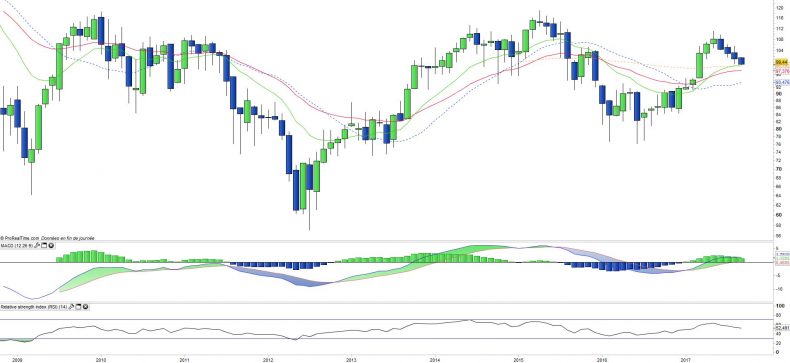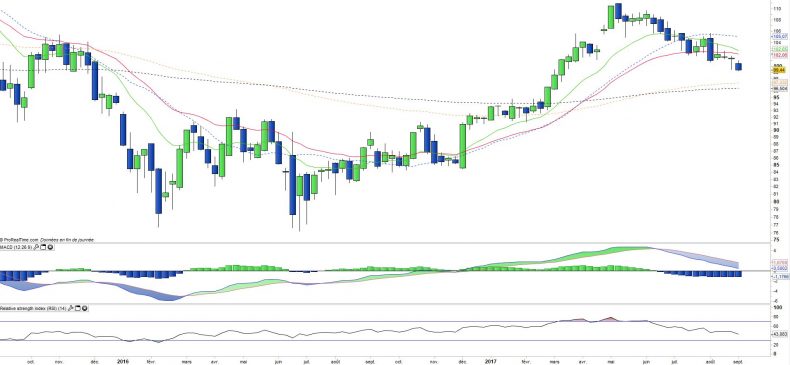Lyxor ETF IBEX (LYXIB) - 08/09/2017
Short term strategy : Negative (10%) / Trend -
Long term strategy : Positive (90%) / Trend -
Characteristics of the ETF
LYXIB (Lyxor) in an ETF which replicates the Spanish index, composed of the country's 35 largest stocks, and weighted according to market capitalization and adjusted for the liquidity of each company included in the index.
The expenses of the ETF IBEX are 0.3%, in line with the average observed for these products, while the AUM reach approximately 774M €. Replication method is direct (Physical) and there is a dividend distribution on a semi-annual basis.
Alternative ETFs : CS1 (Amundi, €), DXIBD (DX-Deutsche Bank, €), EWP (iShares, $)
Index & components
This index, like that of Italy, has the particularity of being overweight in financials, which represent about one third (35%) of its composition (compared to approximately 20% for the stoxx600), including Banco Santander, BBVA and Caixa Bank while consumer goods represent a significant weighting (12%), which is mainly due to Inditex, which weighs more than € 100bn in market capitalization. the second largest sector being utilities (14%), including Iberdrola, Ferrovial and Abertis.
The 10 largest companies account for almost two-thirds of the index, in addition to the companies already named, they also include the telecoms giant Telefonica and the oil group Repsol. The IBEX35 was under pressure in 2016 due to the weak European banking sector and the political problems that left Spain uncertain for months and without government, leading the underperformance versus the Stoxx600. The IBEX declined by 2.2% in 2016-despite a significant catch-up in December-against 1.7% for the stoxx600 for the whole of 2016, while the volatility is rather high which is due to the strong financial weighting.
Spain has seen its macroeconomic situation improve markedly but has suffered from its strong exposure to Latin America under pressure for 2 years, which is particularly linked to Brazil and Venezuela. However, the Brazilian economy is starting to emerge from recession, while Argentina, Colombia and Chile benefit from "pro-business" governments. Political risks have gone away with a takeover by the government of Mr Rajoy and a relative weakening of the populists "Podemos" big losers of the legislative elections of July 2016.
In 2016, Spain has seen its GDP grow by 3.2% keeping the same pace as in 2015. A figure well above that of the euro area, which reached 1.7%. The eurozone's fourth-largest economy has recorded its fifteenth consecutive quarter of growth since the end of 2013, following a free fall which began in 2008 in the aftermath of the property and financial crisis.
Two factors specific to Spain made this sharp rise in GDP possible: the recovery in the labor market, while between 2013 and the end of 2016, the unemployment rate improved from 27% to 18% and 1.2 million from jobs have been created. The second explanation concerns corporates profitability which has become one of the best in Europe, which is explained by the successful reorientation of Spanish companies towards export after the collapse of the domestic market. Growth is expected to reach 3% this year.
Latest developments
After a very good start of the year driven by the rise in financials, the Spanish index stalled from the month of May and made a good part of its gains. Since the beginning of the year, the IBEX35 increased by only 8.3% (compared to + 16.3% at the end of May), but more than the Stoxx600NR (+ 6.2%), mainly due to the consolidation of the banking sector (1/3 of the index), while long-term interest rates are again on the downside.
The ECB has just pointed out that a normalization of monetary policy is premature, on the basis of the strong Euro, European political deadlines and global uncertainties and while inflation remains for the time being very weak. Rates have fallen again, which is a negative factor for bank margins. Moreover, two of the main stocks in the index have been poorly oriented for several weeks, hampering the index: Inditex due to the appreciation of the euro and a more difficult environment than expected this summer in the retail, and Telefonica (telecoms) in the absence of catalysts.
Moreover, the attacks of the summer and a Catalonia increasingly looking for independence weigh on the economic climate of the country.
Monthly data
The monthly chart shows a long-term trend that remains positive, but prices come to test the major support area where the moving averages are located, so it is a pivotal area. Either the index rebounds on these levels and revives the upward trend, or there is a bearish crossing likely to cause a reversal of the underlying trend.
The MACD is tipping over, but no signal has yet been launched. A high-risk area.
Weekly data
On the weekly chart, we can observe the accelerating downward trend, following the more accommodating speech of the ECB, which led to a fall in long rates and the banking sector. The next support area is represented by the EMA100, but it is necessary to monitor a possible crossing of the EMA13x26. Similarly, the oscillators have turned down and the MACD is moving towards the zero line.
The medium-term configuration deteriorates significantly.
ETF Objective
LYXIB is a UCITS compliant ETF that aims to track the benchmark index IBEX 35 Net Return (35 spanish companies).
Characteristics
| Inception date | 19/01/2006 |
| Expenses | 0,30% |
| Issuer | Lyxor |
| Benchmark | Indice IBEX 35 Net Return |
| Code/Ticker | LYXIB |
| ISIN | FR0010251744 |
| Currency | € |
| Exchange | Euronext Paris |
| Assets Under Management | 774 M€ |
| Replication Method | Direct (Physical) |
| PEA (France) | Yes |
| SRD (France) | Yes |
| Dividend | distribution |
| Currency risk | No |
| Number of Holdings | 35 |
| Risk | 4/5 |
Country Breakdown
| Spain | 94% |
| United Kingdom | 3% |
| Netherlands | 2% |
| Luxembourg | 1% |
Sector Breakdown
| Financials | 35% |
| Utilities | 14% |
| Industrials | 14% |
| Consumer discretionary | 12% |
| Telecom services | 9% |
| Energy | 5% |
| Information Technology | 5% |
| Others | 6% |
Top Ten Holdings
| Banco Santander | 16% |
| Inditex | 11% |
| Banco Bilbao | 9% |
| Telefonica | 8% |
| Iberdrola | 8% |
| CaixaBank | 5% |
| Amadeus IT | 4% |
| Repsol | 4% |
| Aena | 3% |
| Abertis | 3% |


